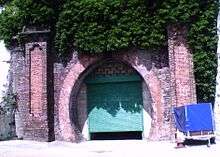Transport in Brighton and Hove
Public transport in Brighton and Hove, on the south coast of England, dates back to 1840. The city has a major railway station, an extensive bus service, a large number of taxis, coach services, a Bus Rapid Transit system under construction and it has previously had trolley buses, ferries, trams, auto rickshaws and hydrofoils.
Rail
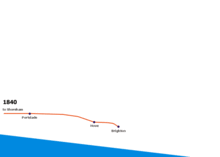


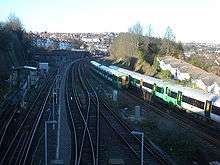
Brighton railway station is the most important station in Sussex, where lines from the north, west and east terminate.
Other railway stations in Brighton and Hove are:
- North of Brighton: Preston Park.
- West of Brighton: Hove; Aldrington; Portslade; Fishersgate (on the boundary with West Sussex).
- East of Brighton: London Road; Moulsecoomb; Falmer.
Brighton station opened in 1840[1] by the London and Brighton Railway, which also established one of the first railway-owned locomotive works (now the New England Quarter). The station provides fast and frequent trains to Gatwick Airport, several London main-line stations, Luton Airport, Bedford and Ashford International.
Regular services also operate via Bristol to Wales.
The express London Victoria service takes 51 minutes, compared with one hour in 1910, 80 minutes in 1859 and up to two hours when the service began in 1841. This route from the original platforms, below the current station, off Trafalgar Street, forms a walkable Greenway through the New England Quarter development and over the 1841 bridge over New England Road.[2]
In addition to the main line to London, trains run to Shoreham-by-Sea (1840) via the West Coastway Line, and Lewes (1846) by the East Coastway Line. The original Hove station (1840–80, Holland Road1905–32) was at the junction of Davigdor, Holland and Cromwell Roads. Current Hove station opened as Cliftonville in 1865 and was joined to the London main line in 1879 by the Cliftonville tunnel.
Other stations within Brighton, with opening dates, are London Road (1877), between Ditching Rise and Springfield Road at some distance from London Road; Moulsecoomb (1980);[3] and Falmer (1846; moved to its present site nearer Brighton in 1890),[4] all on the East Coastway Line. On the Brighton Main Line, non-express London trains stop at Preston Park (opened as Preston in 1869).
Former lines
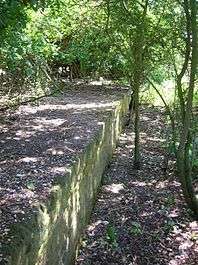
From 1869 until 1932 (and for freight until 1971) there was a line (view map) to Kemptown: Lewes Road (actually on Mayo Road 1873–1932), Hartington Road Halt (1906–11) and Kemp Town terminus and goods yard. The line is closed and only the tunnel under Elm Grove remains (visible from the Freshfield Industrial Estate and below Elm Grove Primary School), and the commemorative locomotive sculpture on the Bingo Hall on Eastern Road (corner of Park Street). The Hughes Road Industrial Estate, Freshfield Industrial Estate, Enterprise Point and Bonchurch Road Park now occupy the alignment, and the bricks from (and alignment of) the Lewes Road viaduct were reused for the Sainsbury's store at the Vogue Gyratory, which has retained a viaduct theme.
There was a branch line[5] from Aldrington[6](then Dyke Junction), to Devil's Dyke (view map) between 1887 and 1939[7] and the track is now a footpath and cycle track north of the Hangleton estate as far as the clubhouse of the Devil's Dyke golf-course. Briefly at the beginning of the 20th century a steep grade funicular railway ran from the bottom of the dyke and a cable car spanned the space above it.[8] Remnants of the concrete piers used to support the cable car are visible on opposite sides of the dyke. There were also Rowan Halt near Rowan Avenue in 1932–38[9] and Golf Club Halt on the city boundary.
Volk's

Volk's Electric Railway, opened in 1883, runs along the inland edge of the beach from the Palace Pier to Black Rock. It is the world's oldest operating electric railway.
Between 1894 and 1901 there was another electric railway, also created by Magnus Volk: the 'daddy long-legs'[10] used tracks in the sea, avoiding the need to build a viaduct. The carriage had tall iron legs and carried the passengers above the waves, running between specially constructed piers at the Banjo Groyne and Rottingdean. It was never able to withstand stormy weather, and after several collapses and reconstructions, and final insurmountable problem of changes to the sea defences, it was abandoned. Remnants of its concrete foundations can sometimes be seen along the route at low tide between the Marina and Rottingdean.
Buses

Brighton & Hove Bus and Coach Company, a subsidiary of the Go-Ahead Group, operates a local bus service with approximately 300[11] buses. In 1997, Brighton & Hove absorbed the former municipal operator, "Brighton Blue Buses", whose history dated back to the 1880s.[12] Most buses bear names of famous local people.
Brighton and Hove Council is involved in a "door-to-door" bus link scheme covering the whole city, opeated by Community Transport (Brighton, Hove and Area) Ltd, incorporated in 1991, on its behalf. Specially adapted buses with passenger lifts or ramps for wheelchairs are used, and journeys can be booked by telephone.
In 2007 the council approved a bus rapid transport system. The £12 million transport project was intended to cut journey times by up to a third with bus lanes linking a proposed Park and Ride site near the A23 and A27 junction to the hospital, railway station and seafront.[13][14] No progress has been made by early 2012.[15]
Taxis
The city is served by a large number of taxis, operated by companies and individual drivers. Those that passengers may hail on the street are painted in a standard white and aquamarine livery, and private hire cars are not required to follow this colour scheme. The unified scheme for Brighton and Hove taxis pre-dates the conjoining of the two towns into one city. The major taxi ranks are in East Street in the Lanes, at the Level in central Brighton, at Brunswick Place in Hove, and at both main railway stations.
Coaches
National Express operates coach services from Pool Valley coach station, near the Palace Pier. Facilities include a bus shelter and two benches. Coaches operate to London Victoria, Gatwick Airport, Eastbourne, Helston, Southampton, Exeter, Plymouth, Heathrow Airport, Stansted Airport.
Auto rickshaws
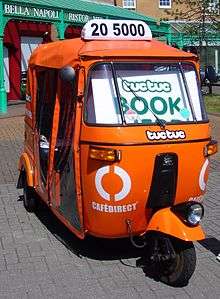
During summer in recent years, a network of auto rickshaws was operated by Tuctuc Ltd. They operated like a bus service, following set routes and picking up at dedicated stops, with a "dial-a-ride" taxi-like option. The routes ran from Brighton Marina to Hove Town Hall via Brighton railway station.[16] The auto rickshaws came in two sizes, were painted in distinct styles, and were powered by compressed natural gas. After a concerted 'dirty tricks' campaign from local taxi drivers[17] Tuctuc ceased operating.
Trams

The first tramway was the Brighton and Shoreham Tramways, which at its fullest extent ran from a terminus in Southdown Road, Shoreham to Westbourne Villas in Hove, on the former boundary between Hove and Portslade.[18] The tramway never penetrated Hove, although a connecting horse-bus (route 112, operated by the Brighton and Preston United Omnibus Company) ran from the Westbourne Villas terminus. Construction took place in 1883 and 1884; the route was opened throughout on 3 July 1884, initially with steam-driven trams. After this proved unsuccessful, other methods of propulsion were tried (including, in 1887, an early battery-powered locomotive) until horse power took over in 1893. The British Electric Traction company took over the operations in 1898, but was unable to agree with any of the local authorities on a strategy for electrification. The tramway was therefore horse-drawn until the end, on 6 June 1913.
Brighton Corporation Tramways[19] operated an extensive network of routes in the first four decades of the 20th century. The first route, from 25 November 1901, ran from the main terminus at the Aquarium (outside Brighton Pier) to Lewes Road, a major route to the north-east; other routes were quickly established, so that by 1904 its full extent had been established.
Cycle routes
Brighton and Hove has a disjointed and incomplete cycle lane network.[20] It includes four routes on the Sustrans National Cycle Network: route 2 along the south coast, route 20 Brighton to Greenwich, route 90 (Brighton to Lewes) and route 82 (Hove seafront to the Devil's Dyke).
Sea
There was a short-lived catamaran ferry in the 1990s to Fécamp in Normandy across the Channel.[21]
References
- ↑ Sue Farrant. The Growth of Brighton and Hove 1840–1939.
- ↑ "Briefing note – new England Quarter April 2005" (PDF). Retrieved 25 April 2007.
- ↑ Collett, Graham (ed.) (1988). Surrey and Sussex by Rail, p.29. Jarrold and Sons Ltd, Norwich. ISBN 0-7117-0331-0
- ↑ Mitchell, Vic and Smith, Keith (1985). South Coast Railways – Brighton to Eastbourne, plate 42. Middleton Press, Midhurst. ISBN 0-906520-16-9
- ↑ J T Howard Turner (1977). The London, Brighton and South Coast Railway Volume 1 Origins and Foundation. ISBN 0-7134-0275-X.
- ↑ Harding, Peter A. The Dyke Branch Line. ISBN 0-9523458-5-4.
- ↑ H P White (1976). Forgotten Railways: South East England. ISBN 0-7153-7286-6.
- ↑ Clark, Paul (1976). The Railways of Devil's Dyke. Crown Press Keighley Ltd. ISBN 0-902844-35-0.
- ↑ "Sussex Branch Lines – Two Branches and a Siding". Retrieved 7 August 2007.
- ↑ "Volk's Electric Railway, Daddy Long Legs, The Brighton to Rottingdean Seashore Electric railway, Brighton, East Sussex, England, UK". Retrieved 29 April 2007.
- ↑ "Brighton and Hove Buses – Current Fleet". Retrieved 31 May 2010.
- ↑ "Traffic and travel information for Brighton & Hove". Retrieved 19 August 2007.
- ↑ "Transport Project Will Cut Journey Times (from The Argus)". Retrieved 25 April 2007.
- ↑ "Brighton and Hove City Council – Major Scheme Business Case – Rapid Transport System" (PDF). Retrieved 25 April 2007.
- ↑ "Rapid transport rap in Brighton and Hove (from The Argus)". Retrieved 14 March 2012.
- ↑ "tuctuc". Retrieved 19 August 2007.
- ↑ web|url=http://www.theargus.co.uk/news/925724.0/
- ↑ Harley, Robert J. Brighton's Tramways, Middleton Press, 1992. ISBN 1-873793-02-2.
- ↑ "Trams outside the headquarters". Retrieved 19 August 2007.
- ↑ "The weird cycle lanes of Brighton". Retrieved 19 August 2007.
- ↑ "Nouvelle liaison rapide transmanche Fécamp-Brighton". Les Échos. May 1995. Retrieved 18 June 2013. ('New quick cross-Channel link between Fécamp and Brighton')
External links
- "Brighton and Hove City Council – travel & transport". Retrieved 19 August 2007.
